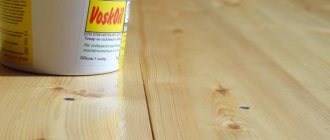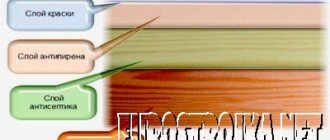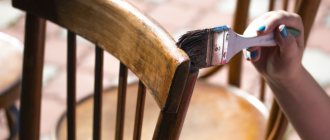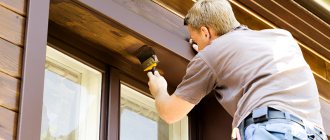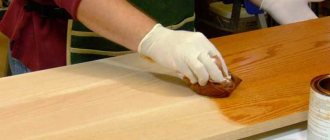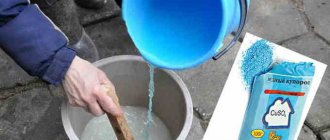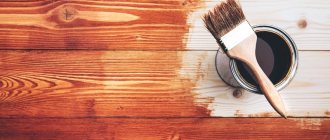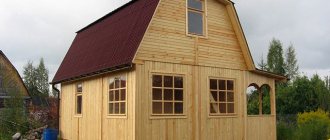Impregnation for wood is a necessary measure to ensure the safety and durability of wooden elements, which was known back in ancient times, when wood was the main building material and was used in house construction, the construction of ships, vehicles and decorative works. The use of wood for operational purposes was widespread in those areas where wood was abundant, but measures to preserve it were considered a necessary condition for any construction.
In modern conditions, natural wood is quite expensive so that it can be used without additional precautions.
Typical wood damage
The need to impregnate wood, that is, impregnate it with preparations that impart appropriate properties and protective properties to extend its service life, is beyond doubt.
This material is highly susceptible to the harmful effects of atmospheric and biological factors, such as:
- Rain and snow - water penetrating into it causes it to swell and shrink, which leads to a weakening of its structure;
- Fungi - appear in wood whose moisture content exceeds 40%. They cause a number of diseases. The blue stain that softwood is prone to shows up as gray-black stains that reduce the aesthetics of the wood.
- Brown algae, which affects both coniferous and deciduous trees, can further reduce its vigor. Rotting leads to complete decomposition of wood. In turn, mold that affects a very wet wood surface is primarily dangerous to people;
UV Radiation - Intense sunlight causes discoloration and increases surface roughness, and also breaks down the lignin that binds wood cells together. As a result, this building material dries out and cracks.
However, it should be remembered that lack of sun is also a disadvantage. This is clearly visible on darkened walls and fences on the north side, where mosses, algae and lichens appear, which do not look aesthetically pleasing;
Insects - feed on both wet and dry wood. The passages they cut out worsen the physical properties of this raw material.
Another argument in favor of wood impregnation is fire safety considerations. Some impregnations may impede ignition or limit the spread of flame.
Fire retardants for fire protection
When talking about wood as an excellent building material, one should not forget about its property: high flammability
For this reason, it would not be entirely correct to ignore compounds that protect wood from burning.
NEOMID 450
This composition is an effective method of protection and is intended for both indoor and outdoor use. The impregnation components, in contact with wood, produce a material that does not ignite or burn well.
Also, the impregnation is endowed with high levels of antibactericidal protection. The manufacturer guarantees seven years of fire resistance and ten years of resistance to fungal diseases. Available in both bleached and tinted versions.
A clear advantage of the composition is double surface protection. The only downside is the long drying time - about two weeks.
"Senezh Ognebio Prof"
This impregnation is also a whole complex for impregnating wood. In addition to fire protection, it creates a good barrier to the penetration of biological threats. It is also protected from water and temperature fluctuations.
Example of color change due to impregnation
It is not advisable to process parts that have direct contact with the ground
It is worth noting that when the surface is impregnated, it changes its color somewhat, but the texture does not suffer. The composition is intended for impregnation of already affected areas of the surface
When working with impregnation, there is absolutely no odor and it can be applied using any method. One of the disadvantages is the rather high consumption during use.
Below are reviews from experts confirming the advisability of using antiseptic impregnations for wood.
Andrey, 42 years old
I have been working with wood for more than 10 years, our company is engaged in the installation and maintenance of wooden log houses, these are small houses made of logs. According to our technology, the final stage in the construction of such a house is always the treatment of logs with antiseptic impregnation “Pinotex Ultra”. During all my time working in the company, I personally have never encountered complaints about the appearance of harmful insects, peeling and cracking of wood. As a rule, people contact us for re-treatment no earlier than after 5-6 years, as prescribed by the manufacturer of the drug.
Nikolay Stepanovich, Rostov
Despite the fact that the effectiveness of treating wood with impregnations from well-known brands is legendary, I made my choice in favor of a domestic manufacturer, and my wooden shed serves as irrefutable proof of the competitiveness of domestic protective products. Four years ago, the structure was treated with Senezh Bio antiseptic for exterior use and was quite pleased with the result. I plan to update the coating no earlier than in a couple of years.
Victor Dmitrievich, Kursk
I would like to share my impressions of working with Aquatex exterior impregnation. The rafter system was treated five years ago and during that time not a single woodworm was noticed. I haven't found any cracks or other defects yet. A preventive examination showed that there is no need to re-impregnate, at least for another 5 - 6 years. I am very pleased with the drug, I recommend it to everyone.
There are quite a lot of similar reviews on the Internet. Negative and sometimes angry reviews are less common, but their nature most often indicates the purchase of a cheap liquid of very dubious origin under the brand name of a well-known company. High-quality impregnations fully comply with the characteristics declared by the manufacturer.
The use of wood impregnations for exterior use is an effective method of protecting wooden structures from most adverse factors. Timely treatment of the material with such compounds helps prevent rotting, the appearance of bugs and the formation of mold. In addition, modern impregnations significantly increase fire safety and reduce the harmful effects of ultraviolet radiation and atmospheric influences.
Types of impregnation for wood
There are several types of impregnations on sale, differing mainly in their chemical composition, which determines their action and application. Some provide comprehensive protection, while others provide protection only against certain hazards, such as insects, fungi, fire, UV radiation or weather.
Some preparations additionally decorate the wood, not only protect it, but also treat already damaged elements.
Therefore, before purchasing you should think:
- What type of structure will we impregnate and where will it be located (structural elements, facades, fences, outdoor furniture, outdoor furniture, interior equipment);
- What type of wood is it made of and what condition is it in?
- What visual effect do we want to achieve?
Salt impregnations are intended primarily to protect structural wood, especially roof trusses, from insects, fungi and fire. They are offered in the form of a powder for mixing with water, less often in the form of a concentrate.
For effective protection, they are applied in a vacuum-pressure chamber or by soaking, due to which they penetrate deeply into the wood structure.
They are not resistant to weather conditions and moisture, so when using them to protect garden wood, it is necessary to additionally use paint or stain.
Attention! Salt-based preparations cannot be used to protect the roof formwork on which the metal covering will be laid, since the salt in the preparation can cause corrosion.
Water-based impregnations are used both inside and outside the building. They protect wood from moisture, insects and microorganisms. They are applied both industrially and using a spray gun or brush.
They are odorless, very effective and dry quickly. They can be applied to slightly damp wood. However, they are not recommended for protecting old, dried wood, which may swell and crack under their influence.
- In this case, it is better to use a dissolving agent. This is effective protection against moisture, ultraviolet rays and pests. Most often applied by brush or dip.
- You must strictly follow the manufacturer's instructions. Some solvent-based impregnations are suitable for external use only. During application, please remember that they may be flammable.
Another category is coloring impregnations. As the name suggests, they are mainly used to decorate wood. Although they, in addition to coloring pigments, also contain fungicides and insecticides (which is why they are classified as impregnating agents), the wood coated with them should be protected with an additional layer of stain or clear varnish.
Then the protection will be more complete. They are applied with a brush to well-polished surfaces - both inside and outside buildings.
Attention! Some products in a clear version are intended for primary impregnation, then you should use a color impregnation with properties adapted to your needs.
The difficult problem of choice
What is the best impregnation to choose? This is a question that requires a professional approach and a clear understanding of the tasks facing a person. A huge selection of water-soluble compounds, oil pastes, volatile mixtures and other types baffles the uninitiated. What should be highlighted in the first place is not the question of what color - colorless, white or black impregnation, but its quality and efficiency.
So which wood impregnation is best? If the deck varnish is for a wooden floor, then it is Finnish, and the antiseptic is of high quality to protect the wood from gray-shaggy or black mold. The choice of impregnation should be carried out with a professional approach, and for this it is always better to consult with specialists.
Review of Pinotex decorative impregnation (1 video)
Different types of impregnations (24 photos)
Wood impregnation methods
Wood can be impregnated in different ways. Some of them are industrial methods, others can be used at home:
- Vacuum-pressure method. It is carried out in special devices called autoclaves, where air is sucked from the wood cells, and impregnation takes its place. This is the most effective method, because the drug penetrates the wood to a great depth, perfectly protecting the building material. This method is used, among other things, to impregnate structural timber, such as roof truss elements;
- Dipping involves impregnating wood by completely immersing it in an impregnating agent. This is usually done in specialized institutions. Carrying out such an event on your own at a construction site is quite troublesome. You need to dig a hole, line it with an insulating film, fill it with impregnation, soak the structural elements in it for several tens of minutes, and then dry the wood. With a small amount of building material, this is unprofitable, since the loss of impregnation is significant;
- Shower: the wood is impregnated using a pneumatic sprinkler. You don't have to do this in an industrial setting, you can even use a regular portable crop protection device to spray your garden. This method, although fast, is ineffective, as it involves large losses of impregnation. Therefore, it is not recommended to secure hard-to-reach places, for example, fragments of gazebos. However, it is well suited for large flat surfaces, such as wooden parts of the facade. Due to the fact that spraying causes the spray of toxic substances, it is necessary to remember to wear appropriate clothing and a protective mask;
- Manual impregnation involves applying impregnation to wood with a brush, roller or sponge. This is the most popular method used at home. Most often, fences, balustrades, gazebos, awnings, garden furniture, etc. are painted.
Safety and Applications
Antiseptic "Senezh Impra" for deep impregnation of wood
Certified compositions used for autoclave impregnation, made on the basis of copper carbonate, organic or inorganic boron compounds, triazole, etc., meet all modern safety requirements: do not contain arsenic and other hazardous components, do not emit harmful substances and allergens when heated in the sun, have ultra-low emissions into the soil. However, even non-toxic chemistry remains chemistry, and impregnated wood should be used in the conditions for which it is intended.
And first of all, this is a street. The material is ideal for facade cladding and construction of various garden structures (fencing, decking, canopies, frames of greenhouses and beds, gazebos, etc.). In addition, it can be used for the manufacture of structural elements of buildings, including bathhouses, hidden under finishing and therefore in need of enhanced protection from damage (subfloors, floor beams, sheathing, frame beams, mauerlat, pillars and rafters, etc.). P.).
The main preparations used in our country for impregnation are the imported Tanalith® and the well-known domestic Senezh. The difference in price between them is significant, so it is important that the manufacturer does not pass one off as the other, which means be sure to ask to see a certificate.
In addition to antiseptic treatment, deep impregnation of wood with fire retardants or combined compounds can also be performed. In particular, even structural plywood is subjected to similar fire protection
Photo of wood impregnation
Green or brown?
Preservative impregnation gives the wood a thick green, or rather, marsh color with a bluish tint in the area of knots. After a few weeks, under the influence of ultraviolet light, it loses its intensity and acquires a pleasant yellowish tone. By adding color to the composition, you can initially make the material brown. This does not affect the processing result in any way, except that it makes the product more expensive, and it also gradually turns pale and acquires a grayish tint. In both cases, impregnated wood must be protected from fading with oils or glaze coatings with a UV filter effect,
to which you can add the desired dye.
